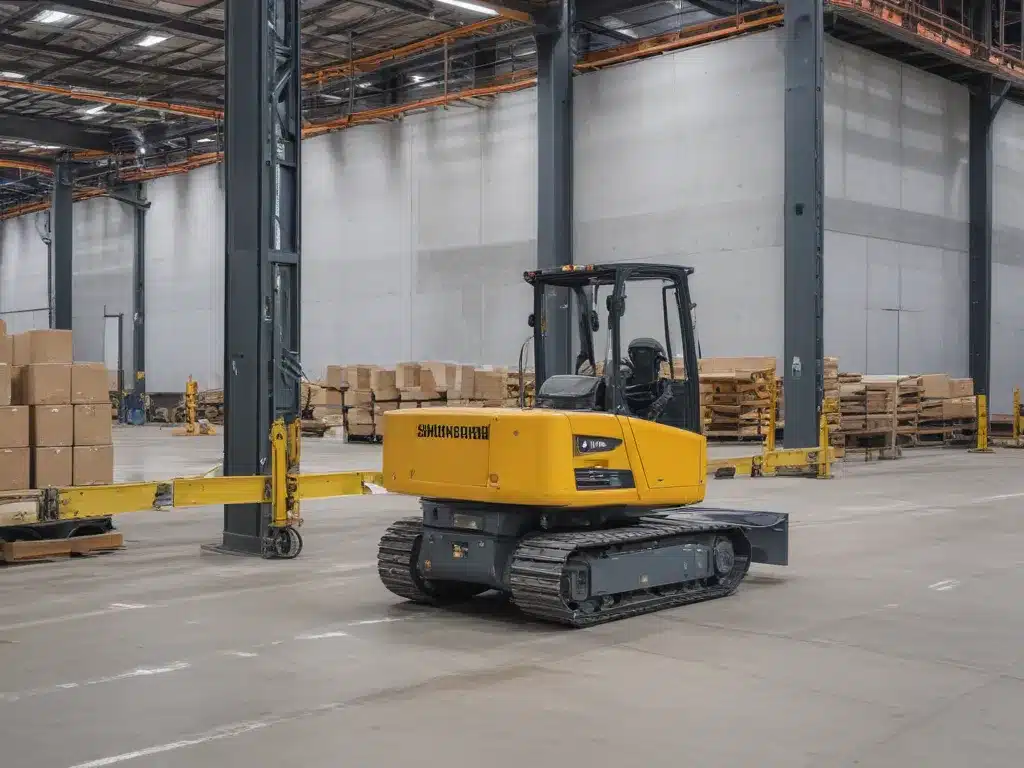
The Quest for Efficiency in the Construction World
My friends, let me tell you a story about a̅ revolution brewing in the construction industry. It’s a tale of cutting-edge technology meeting good ol’ fashioned hard work, and the result is a beautiful symphony of efficiency. Brace yourselves, because we’re about to delve into the world of automated guided vehicles (AGVs) and how they’re changing the game for moving construction equipment.
What the Heck Are Automated Guided Vehicles?
Before we get too carried away, let’s break down what we’re talking about here. Automated guided vehicles, or AGVs for short, are essentially robots on wheels. These bad boys use sensors, lasers, and fancy software to navigate around construction sites without needing a human driver. They can follow pre-programmed routes or use real-time data to find the most efficient paths, all while carting around heavy equipment and materials.
Now, I know what you’re thinking: “But wait, we already have forklifts and cranes for moving stuff around!” And you’re absolutely right, my friend. But here’s the kicker – AGVs are like those trusty workhorses, but on steroids. They never get tired, they don’t need breaks, and they can work around the clock without complaint (sorry, union reps!).
The Benefits of AGVs: A Construction Company’s Dream Come True
Okay, so why should you care about these robotic helpers? Well, let me break it down for you:
-
Increased Efficiency: AGVs can move materials and equipment faster and more accurately than their human counterparts. They don’t get distracted, they don’t take coffee breaks, and they don’t call in sick. That means less downtime and more productivity on the job site.
-
Improved Safety: Construction sites can be pretty dangerous places, but AGVs help mitigate risks. They’re programmed to follow safety protocols to a tee, reducing the chances of accidents and injuries caused by human error.
-
Cost Savings: While the initial investment in AGV technology might seem steep, the long-term cost savings can be substantial. You’ll spend less on labor, reduce the risk of costly accidents, and increase overall efficiency – a win-win for your bottom line.
-
Versatility: These robotic workhorses can handle all sorts of tasks, from transporting heavy equipment to delivering materials precisely where they’re needed. They’re like the Swiss Army knives of the construction world.
Real-World Examples: AGVs in Action
Now, I know what you’re thinking: “That all sounds great in theory, but how do these things actually work in the real world?” Well, buckle up, because we’re about to take a look at some real-life examples of AGVs kicking butt and taking names on construction sites.
The Grand Central Terminal Renovation
When it came time to renovate the iconic Grand Central Terminal in New York City, the construction team faced a unique challenge: how to move materials and equipment through the bustling train station without causing major disruptions. Enter the AGVs.
These robotic helpers navigated the crowded corridors with ease, transporting supplies and tools to the work areas with precision. They followed pre-programmed routes and adjusted their paths in real-time to avoid obstacles, all while keeping the terminal running smoothly.
Atchison Construction Inc. AGVs Implementation
Speaking of real-world examples, let’s talk about the amazing work being done by Atchison Construction Inc.. This forward-thinking company has embraced AGV technology with open arms, and the results have been nothing short of impressive.
By incorporating AGVs into their operations, Atchison Construction has seen a significant boost in efficiency and productivity on their job sites. These robotic workhorses tirelessly transport materials and equipment, freeing up human workers to focus on more complex tasks.
But that’s not all – the use of AGVs has also improved safety standards, reducing the risk of accidents and injuries caused by human error or fatigue. And let’s not forget the cost savings – with increased efficiency and reduced labor costs, Atchison Construction is saving big bucks while delivering top-notch results for their clients.
The Future of AGVs: Where Do We Go from Here?
As impressive as AGVs are today, the future holds even more exciting possibilities. Imagine a world where AGVs can communicate and coordinate with each other, forming a synchronized robotic ballet on the construction site. Or what about self-charging AGVs that never need to stop for a power break?
The possibilities are endless, my friends. And with companies like Atchison Construction leading the charge, we can expect to see even more innovative applications of AGV technology in the years to come.
Wrapping It Up: The AGV Revolution Is Here
So, there you have it, folks – the lowdown on automated guided vehicles and how they’re revolutionizing the construction industry. From increased efficiency and improved safety to cost savings and versatility, these robotic workhorses are checking all the boxes.
And let’s not forget the real-world examples we covered, like the Grand Central Terminal renovation and the impressive work being done by Atchison Construction Inc.. These trailblazers are paving the way for the future of construction, one AGV-powered job site at a time.
So, what are you waiting for? Embrace the AGV revolution and watch as your construction projects soar to new heights of efficiency and productivity. Trust me, your bottom line (and your hard-working crew) will thank you.





